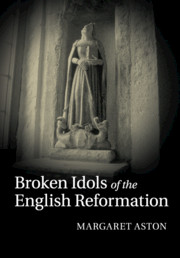
-
Select format
-
- Publisher:
- Cambridge University Press
- Publication date:
- December 2015
- November 2015
- ISBN:
- 9781139032834
- 9780521770187
- 9781108744201
- Dimensions:
- (254 x 178 mm)
- Weight & Pages:
- 2.33kg, 1128 Pages
- Dimensions:
- (244 x 170 mm)
- Weight & Pages:
- 1.9kg, 1128 Pages
- Subjects:
- British History after 1450, History, Religion, Church History
You may already have access via personal or institutional login- Subjects:
- British History after 1450, History, Religion, Church History
Book description
Why were so many religious images and objects broken and damaged in the course of the Reformation? Margaret Aston's magisterial new book charts the conflicting imperatives of destruction and rebuilding throughout the English Reformation from the desecration of images, rails and screens to bells, organs and stained glass windows. She explores the motivations of those who smashed images of the crucifixion in stained glass windows and who pulled down crosses and defaced symbols of the Trinity. She shows that destruction was part of a methodology of religious revolution designed to change people as well as places and to forge in the long term new generations of new believers. Beyond blanked walls and whited windows were beliefs and minds impregnated by new modes of religious learning. Idol-breaking with its emphasis on the treacheries of images fundamentally transformed not only Anglican ways of worship but also of seeing, hearing and remembering.
Reviews
'Aston’s forensic attention to detail, penetrating insight and comprehensive mastery of her subject are on show from the first page. This is a book that could only have been written after a lifetime of scholarly enquiry, and is a worthy testament to Aston’s formidable skills as both writer and historian. … Broken Idols remains a suitably powerful, perceptive and significant final contribution to the field by a truly brilliant and inspirational scholar.'
Jonathan Willis Source: Journal of Ecclesiastical History
Contents
Metrics
Altmetric attention score
Full text views
Full text views help Loading metrics...
Loading metrics...
* Views captured on Cambridge Core between #date#. This data will be updated every 24 hours.
Usage data cannot currently be displayed.
Accessibility standard: Unknown
Why this information is here
This section outlines the accessibility features of this content - including support for screen readers, full keyboard navigation and high-contrast display options. This may not be relevant for you.
Accessibility Information
Accessibility compliance for the PDF of this book is currently unknown and may be updated in the future.


